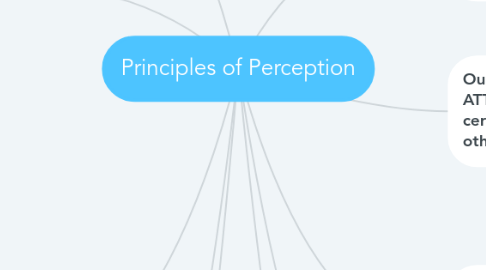Principles of Perception
da XplaYnZ xplaynzent


1. Perceptual Set is the tendency for perceptions to be influenced by expectations or preconceptions.
2. There are two general modes of visual processing: bottom up(lines and angles make up letters or numbers/ sounds and instruments recognized in a symphony or song etc.) and top down( images recognized as a whole such as remembering faces)
3. Gestalt psychologists observed the ways people assemble bits of sensory info into meaningful wholes, which was the basis for the Laws of Perceptual Organization.
3.1. Figure and Ground- things such as people, clouds would be considered Figures, whereas the street and sky would be the background in the same situation. Sometimes an outline is displayed in such a way one can not decipher between the figure and background.
3.2. Grouping is another way we perceive and classify images
3.2.1. Proximity-objects near each other are thought as belonging in the same set
3.2.2. Similarity- similar objects belong to same group
3.2.3. Continuity- tendency to perceive series of stimuli as a unified form when it appears to represent continuous pattern
3.2.4. Closure- grouping disconnected pieces into one meaningful whole
3.2.5. Connectedness- perceiving objects as belonging together when positioned or moving together
4. Depth Perception
4.1. Binocular Cues rely on both eyes. Since our eyes are a few inches apart, they receive different images. The brain uses this Retinal Disparity as cues to relative distance of objects.
4.2. Monocular Cues depend on one eye only. Most of our perception is a result of these cues which include: relative size, interposition, relative clarity, texture gradient, linear perspective, and shadowing
5. Visual Illusions are misperceptions of visual stimuli(eyes seem to be playing tricks on us). The Muller-Lyer illusion is a common one in which lines of the same size appear different do to angles that play on our cues for depth perception.
6. PERCEPTION- process by which the brain interprets sensory information, turning it into meaningful representations of the outside world
6.1. Perception allows one to place meaning on the sensory information being taken in
7. Our brain uses SELECTIVE ATTENTION to focus on certain stimuli and ignore others.
7.1. Several factors contribute to selective attention, including the circumstances such as meaning or emotional significance, and one's motivational state( ex. hunger or thirst).
7.1.1. On the same note, repeated exposure can either increase attention to certain stimuli, or cause one to become HABITUATED or ACCUSTOMED to certain stimuli.

